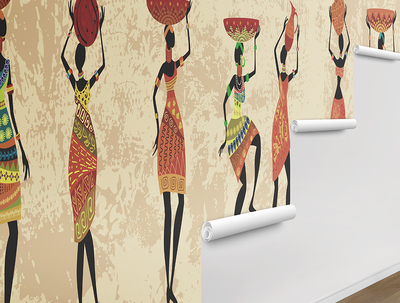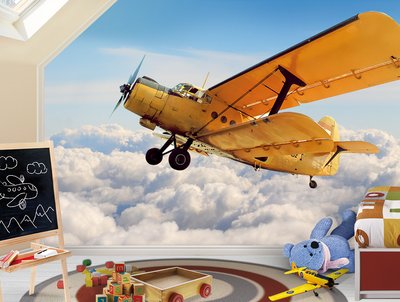Digital wallcoverings are growing in popularity as end users cotton on to the idea of bespoke designs at reasonable prices. With low barriers to entry, it could be an attractive new market for printers, argues Simon Eccles.
Historically wallpaper has always seen a great divide between expensive bespoke designs, often hand printed with traditional wood blocks, and affordable mass produced stuff that ironically has tended to use the most interesting printing technologies of its time. Digital printing means that we can now have something of the best of both worlds: anyone can design or commission bespoke wallcoverings which can then be affordably printed in very small quantities. You could spread images across wall-sized murals or set up abstract patterns, with software to device the strips and overlaps. It is feasible and surprisingly affordable to produce a single room, or even just one wall this way.
Demand for custom wallcoverings range from consumers to businesses, taking in domestic rooms through to hotels, restaurants, retail stores, office foyers and plenty more. ‘For hotels and restaurants, wallcoverings are actually cheaper than using paint,’ points out Francesca Selby, marketing coordinator at Papergraphics, a big supplier of digitally printable wallcoverings. ‘Paint gets marked and has to be repaired. Wallcoverings can withstand people brushing past.’
The increased use of wallcoverings is due to advances in the media and pastes rather than the print process. Papers that have to be pasted before application are being superseded by ‘paste the wall’ types, which makes the hanging stage a lot easier.
However, going digital widens the appeal still further, said Ms Selby. ‘People are starting to personalise everything now. It’s going into fashion, mugs, iPhone cases. Certainly when it comes to digital wallpapers and wallcoverings, they are starting to want them to be bespoke. Children’s bedrooms are a prime example. It is very easy now to chop and change whenever they want.
‘You’ll see a lot of companies that mainly deal with commercial decoration setting up a special unit on the side to cover the domestic market. If promoted and done properly they are tapping into a massive channel of revenue. The brilliant thing is you don’t need to get involved in installation. You can pre-cut the panels with an overlap and cut the join on the wall. The public decorate their own houses and many households are familiar with hanging their own wallpaper.’
Derric Landor, managing director of Landor UK, has been selling digitally printable self-adhesive Phototex wallcovering fabric for several years. ‘You can have branding, you can have art and design, everything really,’ he said. ‘You can blend the branding with the décor. You can really change the ambience of a restaurant, or a bank. You can visualise mixing the branding with a warm environment, seamlessly.
‘The whole market is starting to recognise that where margins had been cut on standard high demand commodity print, there are areas like this that are up and coming. It is giving the print market new revenue streams that they can grow and expand.’
If you want to break into this as a new market it is encouraging to know that the digital printers that can produce short run bespoke wallcoverings are completely standard, so they can be used for other types of work as well. An inkjet receptive coating may be needed for some printer types but otherwise the choice of papers is pretty well the same as for pre-printed types.
‘UV curable, eco-solvent or Latex inks, all work absolutely fine,’ said Ms Selby. ‘UV is great for durability. More and more people prefer Latex due to the eco-credentials and no smells. Solvent has to cure for a while, but the smell does disappear. The fact that the media works on the majority of machines means that you’re not limiting the user. If a customer only has a Roland, then he can use that.’

Obviously a roll fed printer is needed, but while you might assume wallpaper is an ideal wide format subject, in fact the practicalities of handling it while installing it on walls limit the widths that people actually want.
If the wallpaper is too wide then it’s hard to handle and align when you are up a ladder, especially the self-adhesive media that has to be peeled from its backing. Most people choose 24 inches as a practical size. Tim Stockley, managing director of Colourbyte, says that he sells mostly this size of wallpaper media. Although a small amount of sales are 914 mm (36 inch) width, he says this does not seem to be used for wallpaper type applications.
A wider, faster printer might be preferable even if you only run narrow rolls, so you would be able to use the same printer for other types of work. It is comparatively rare to be able to print digitally edge to edge on a roll, but this is easily solved by using a slitter wheel trimmer.
Alternatively you might consider a production press: the widest Xeikon web fed digital toner presses take 512 mm rolls (with an unprinted margin), making 20 inch rolls practical. High speed web fed inkjets might be technically capable of wallpaper work, though economics suggests that this would not be commercially viable.
Last year HP launched a big push into this market, with its ‘digital printing solution for wall decoration.’ This is based on its large format Latex ink printers, together with approved HP and third party media, plus dedicated design software including the WallArt solution that lets customers enter details of their wall layouts and then add designs to fit. An alliance with the Fotolia picture library also allows customers to search for and select images and designs if they do not provide their own.
It is now possible to integrate WallArt into print service providers’ own websites, providing a complete design and uploading system. This could be integrated with a third party e-commerce shopping cart to allow online ordering and payment.
Latex printers are well suited to wallcovering work, according to Terry Raghunath, HP’s business development manager for decorative printing applications. The inks are water based, so they do not smell after printing, but the pigments are carried in polymers that form a durable waterproof bond with the media.
‘What’s really important for us is to be able to offer all the supporting details that an end user needs for wallcoverings,’ he said. The key is the media. ‘Certification is a big thing. Wallpaper this to say it’s fire resistant, scratch resistant, colour stable etc. Just printing any kind of paper on your digital printer is no longer enough.’
Once the legalities are solved, the choice of media is up to the customer. ‘The wallcovering industry has a lot more in common with fashion than signage,’ said Mr Raghunath. ‘The tactile part is extremely important. The more textile-like or vintage it feels, the better people like it.’
There is a wide and growing choice of paper and fabrics suited to inkjet or toner printers. For instance, Papergraphics produces two printable ranges in its own factory in Kent: a high end long life fabric called Digimura and a paper media called Muramour, that costs less and is intended for shorter lifetimes. Both are available in a wide range of textures and finishes, including special effects such as metallics.
The past few years have also seen the development of self-adhesive printable fabrics, with advanced adhesives that not only allow repositioning, but the material can be removed even after several years, without damaging the underlying wall. It can even be used for vehicle signage and similar outdoor applications if a waterproof coating or laminate is applied.
The first digitally printable self-adhesive and repositionable fabric to reach the UK was Photo Tex. This is made in Korea, for the US based Photo Tex Group. It is distributed throughout Europe and some overseas territories by Landor UK, which calls it Phototex Digital Wallpaper.
There are versions of Phototex for both solvent and aqueous inkjets. Recent additions are the EX version with stronger adhesive for rough or poorly prepared walls; and a high opacity material to go over dark or strongly coloured backgrounds. All are supplied in 30 metre rolls in widths from 24 to 60 inches. Typical prices for 610 mm x 30 metre Phototex are £210 for aqueous and £167 for solvent. However there are boxes of 100 x SRA3 cut sheets. The solvent type can also be used with UV or Latex inkjets, while aqueous should also work with Latex.
Mr Landor recommends that his company’s Liquid Laminate is applied as a protective wipe-clean coating. This can be done by a hand roller after printing, or at the final site. Landor recently introduced a dedicated Wallpaper Matte liquid, but the gloss, satin and matte coatings in the standard range would work too.
Last year Colourgen became UK agent for Kodak’s range of large format consumables. This includes a Kodak branded version of Photo Tex, though only in the aqueous version and with no cut sheet availability. Colourgen has also recently started selling a solvent/Latex receptive wallcovering, DecoTex, which has a thicker base than usual, meaning no show-through, according to marketing manager Melanie Ensor.
Another repositionable fabric range is sold by Colourbyte, called Stickytex, for either aqueous or solvent/Latex inkjets. This costs less than Phototex (£84 for a 610 mm x 30 metre roll) and is thicker (at 220 gsm), with a stronger adhesive, according to Colourbyte MD Tim Stockley. He also sells Graffiti and Camouflage, a pair of non-woven paper wallcoverings for conventional pastes, again for aqueous and solvent respectively.
Digital wallcoverings are an exciting new market with low barriers to entry and no particular new skills to learn if you have already got a large format printer. It fits in well with online design and ordering software. As ever, the main challenge is devising a marketing strategy and then getting out there and selling it.





